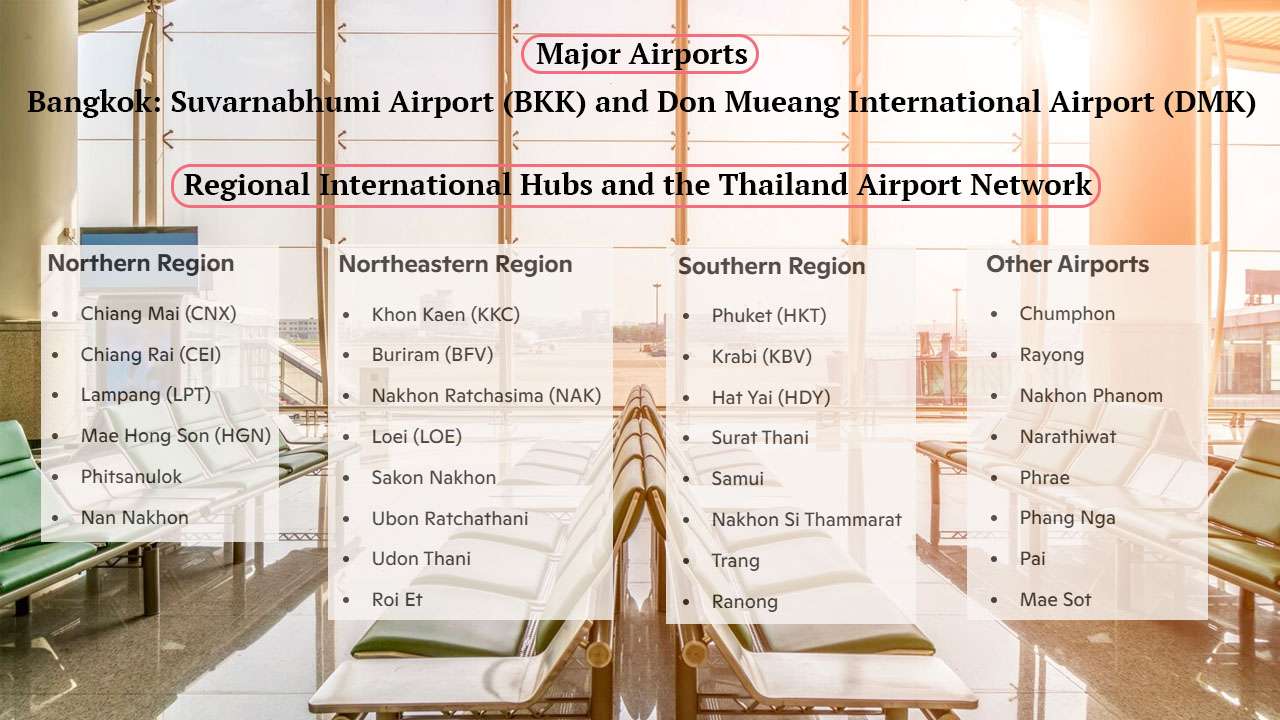
The Gateway to Southeast Asia
Thailand maintains a robust aviation infrastructure serving as a crucial regional hub. The country’s extensive network includes over 30 commercial airports nationwide. This comprehensive system links major global destinations with remote regional provinces. This guide provides a detailed overview of all airports in Thailand and their vital roles. Our focus covers both domestic and international connectivity across all regions.
Global Aviation Hubs: Thailand’s Primary Gateways
These two air transportation centers are considered the most significant major airports in Thailand. They facilitate the majority of long-haul passenger and cargo traffic globally.
A. Suvarnabhumi Airport (BKK)
- Role: BKK serves as Thailand’s primary aviation hub. It handles the largest volume of international traffic. The airport is vital for long-haul routes and global alliance connections.
- Connectivity: This facility focuses heavily on long-distance international flights. It is also an essential transit and cargo hub for the Asian region.
B. Don Mueang International Airport (DMK)
- Role: Don Mueang International Airport is internationally recognized as the world’s first dedicated Low-Cost Carrier (LCC) hub.
- Connectivity: This airport specializes in short to medium-haul international flights. Moreover, it is a key departure point for numerous low-cost domestic routes.
Regional International Hubs and the Thailand Airport Network
These regional facilities are essential components of the Thailand airport network for both tourism and economic activity. They are managed primarily by Airports of Thailand (AOT) and the Department of Airports (DOA).

Northern Thailand: Connecting Culture and Mountains
This region features two major international airports driving tourism and commerce.
| Airport (IATA Code) | Province | Primary Connection |
| Chiang Mai (CNX) | Chiang Mai | International/Domestic |
| Mae Fah Luang (CEI) | Chiang Rai | International/Domestic |
| Phitsanulok (PHS) | Phitsanulok | Domestic |
| Nan Nakhon (NNT) | Nan | Domestic |
| Lampang (LPT) | Lampang | Domestic |
| Mae Hong Son (HGN) | Mae Hong Son | Domestic |
| Phrae (PRH) | Phrae | Domestic |
| Pai (PYY) | Mae Hong Son | Domestic |
Northeastern Thailand (Isaan): Regional Economic Powerhouses
The Isaan region relies on several large, modern airports that primarily serve domestic routes. They have established international capabilities.
- Key Airports: Khon Kaen (KKC), Udon Thani (UTH), and Ubon Ratchathani (UBP) are major regional centers. They are equipped to handle international flights to neighboring countries.
- Connectivity: These facilities support major business travel and connect populations across the vast northeast. Smaller facilities like Buriram (BFV) and Roi Et (ROI) assist in local travel needs.
Southern Thailand: Coastal and Island Access
The South possesses critical international gateways catering to global beach tourism and trade.
- Phuket (HKT) and Krabi (KBV): These serve as significant international entry points. They directly connect beach destinations with European and Asian markets.
- Hat Yai (HDY): This airport is a major commercial and travel hub for the lower southern provinces. It provides essential international links.
- Other Domestic Gateways: Trang (TST), Nakhon Si Thammarat (NST), and Surat Thani (URT) connect passengers to the mainland and island ferry terminals.
Specialized Gateways: Private and Strategic Airports
The all airports in Thailand ecosystem includes privately run facilities offering boutique travel experiences and strategic government assets.
- Samui Airport (USM): Operated by Bangkok Airways, this is a beautiful privately run international airport. It connects the popular Samui island directly with Asian and other regional hubs.
- Trat Airport (TDX): Also private, this facility is the direct air gateway to the popular islands of Ko Chang and Ko Kood. It maintains international customs capabilities for charter flights.
- U-Tapao International Airport (UTP): Jointly operated with the Royal Thai Navy, this is the main gateway for the Eastern Economic Corridor (EEC). It is strategically important for both tourism and business.
Future Outlook
The comprehensive network of all airports in Thailand reinforces the country’s status as an undisputed travel hub. Continuous investment is ensuring high safety and capacity standards. This robust system meets the dynamic needs of both global tourism and expanding domestic commerce.
Love this? We’ve got more where that came from — find us at @thaiimpact on X.





